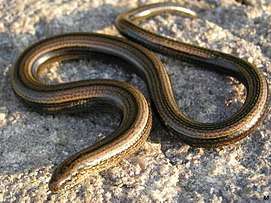Anguimorpha
Anguimorphs of the infraorder Anguimorpha include the anguids (alligator lizards, glass lizards, galliwasps and legless lizards). The infraorder was named by Fürbringer in 1900 to include all autarchoglossans closer to Varanus and Anguis than Scincus. These lizards, along with iguanians and snakes, constitute the proposed "venom clade" Toxicofera of all venomous reptiles.[1]
| Anguimorphs | |
|---|---|
 | |
| Scientific classification | |
| Kingdom: | Animalia |
| Phylum: | Chordata |
| Class: | Reptilia |
| Order: | Squamata |
| Clade: | Toxicofera |
| Suborder: | Anguimorpha Fürbringer, 1900 |
| Subclades | |
Families
Anguidae
There are 9 genera found within the Anguidae family. They are characterized by being heavily armored with non-overlapping scales, and almost all having well-developed ventrolateral folds (excluding Anguis). Anguidae members can, however, be somewhat difficult to identify in their family, as members can be limbed or limbless, and can be both viviparous and oviparous. Anguidae members have pterygoid teeth. Many members of this family have tail autonomy.
Anniellidae
There is only one genus within the Anniellidae family, comprising 6 species of American legless lizards. They are characterized as having no limbs, and can be found in California and Baja California. They have wedge-shaped heads and a countersunk jaw that allows them to bury themselves in sand or loose soil, which they can drink water from if the soil has a water quantity greater than 7%. They give live birth and usually have two offspring.
Diploglossidae
There are three genera in the Diploglossidae family. They are characterized by having very long, automatized tails, small and well-developed limbs, and no ventrolateral fold. They do have bicuspid posterior teeth. They give both live birth, and lay clutches, according to the genus.
Xenosauridae
There is only one genus, with 6 species, found in the Xenosauridae family. This family is both dorsally and ventrally covered in knob-like scales. Their tail is about 1.2 times the length of their body. They give live birth, with a litter usually consisting of two offspring, although they can have up to eight. Gestation takes eleven to twelve months. They are primarily insectivores.
Helodermatidae
The family Helodermatidae (beaded lizards) has only one genus with 5 species, including the Gila monster. This family is the only known family of lizards that have well-developed venom glands. In addition, they have short, non-automated tails. They have somewhat tubercular scales both dorsally and laterally, with their ventral scales being smooth, and being larger than the dorsal and lateral scales. They are oviparous, with clutch sizes averaging about 6 eggs per clutch. These lizards have a pectoral girdle, meaning that they must push their swallowed prey past it in order to eat. Despite this limitation, these lizards have been observed eating prey up to 33% of their body weight.
Shinisauridae
The family of Shinisauridae is only made up of one species, Shinisaurus crocodilurus, the Chinese crocodile lizard. This species is semiaquatic, found in forests along streams. These lizards can hold their breath underwater for up to thirty minutes at a time. . Found in southern China, this species is viviparous, with litters ranging from 2-7 individuals. This species has well-developed limbs and has a tail that is around 1.2 times the length of its body. Tail autonomy is not present in these lizards.
Lanthanotidae
The family Lanthanotidae consists of a single species, the earless monitor lizard (Lanthanotus borneensis). This species has thick skin, which is covered by small, rounded scales that appear in rows. The main defining feature that distinguishes this species from other monitors is its lack of a parietal eye and the lack of a hemibaculum. The species is presumed to be semiaquatic, but little is known about its wild habits, as most information and study comes from captive individuals. It is only found on a single island of off the coast of Singapore.
Varanidae
The Varanidae are a family of carnivorous and frugivorous monitor lizards, which contains one extant genus (Varanus) with 73 species, including the Komodo dragon. They can be characterized by their thick skin and small, rounded scales. The ventral scales are slightly larger than the dorsal scales. They have a parietal eye and a hemibaculum. This completely oviparous family has a clutch size that correlates with the body size. No members of this family exhibit parental care. They also have limbs that are relatively small for their body size. The family is also broken up into 9 distinct morphological subgroups. Some members of this family, such as the Komodo Dragon, are believed to be venomous.
Taxonomy
The cladogram below is based on Palci and Caldwell (2010a), Caldwell and Palci (2010b),[2][3].
| Anguimorpha |
| ||||||||||||||||||||||||||||||||||||||||||||||||||||||||||||||||||||||||||||||||||||
References
- Fry, B.; et al. (February 2006). "Early evolution of the venom system in lizards and snakes". Nature. 439 (7076): 584–588. doi:10.1038/nature04328. PMID 16292255.
- Alessandro Palci & Michael W. Caldwell (2010a). "Redescription of Acteosaurus tommasinii von Meyer, 1860, and a discussion of evolutionary trends within the clade Ophidiomorpha". Journal of Vertebrate Paleontology. 30 (1): 94–108. doi:10.1080/02724630903409139.
- Caldwell, Michael W.; Palci, Alessandro (2010). "A new species of marine ophidiomorph lizard,Adriosaurus skrbinensis, from the Upper Cretaceous of Slovenia". Journal of Vertebrate Paleontology. 30 (3): 747–755. doi:10.1080/02724631003762963.
Vitt, Laurie J., and Janalee P. Caldwell. Herpetology: An Introductory Biology of Amphibians and Reptiles. 4th ed., Academic Press, 2014.